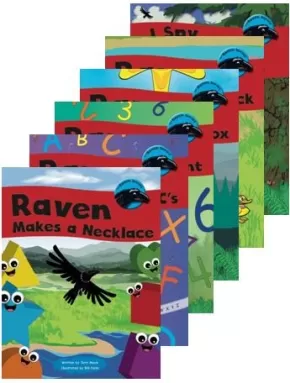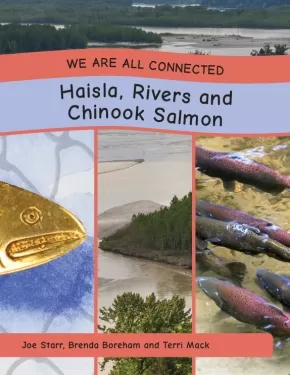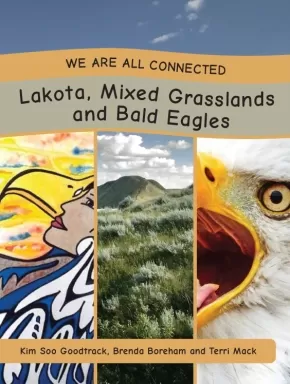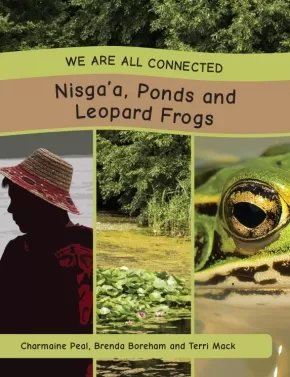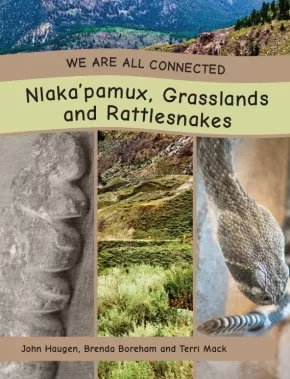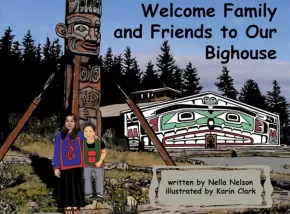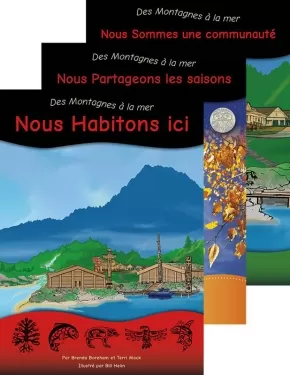
Kwakwaka’wakw (Kwakiutl)
31
-
45
of
93 Results;
Sort By
Go To
of 7
Mini Raven Series Set
 $22.95
$22.95

Artists:
Format:
Paperback
Text Content Territories:
Indigenous Canadian; First Nations; Kwakwaka'wakw (Kwakiutl);
Grade Levels: Preschool; Kindergarten;
ISBN / Barcode: 9781771745987
Synopsis:
Synopsis:
The Raven Series is a set of six books written for the emergent reader and learner. Each book focuses on a specific learning intention that builds on strengthening learning with the support of an adult.
The titles and their learning intentions are:
- Raven and the Box: promotes an oral retell
- Raven and Duck: basic concepts
- Raven Can Count: number recognition
- I Spy Raven: rhyme and perspective
- Raven Learns the ABC's: letter recognition, vocabulary building
- Raven Makes a Necklace: colours and patterns
These 3"X4" books are great for young readers just learning how to read.
The Big Book Raven Series can be found in the Raven Series Category.
Additional Information
Each book has 8 pages | ISBN 9781771745987
We Are All Connected: Coast Salish, Coastal Rainforests and Cougars
 $21.95
$21.95

Format:
Paperback
Text Content Territories:
Indigenous Canadian; First Nations; Salish; Coast Salish;
ISBN / Barcode: 9781771742504
Synopsis:
Synopsis:
“We Are All Connected” is a series that explores how we all live together in a shared balance upon Mother Earth. Each book explores a specific ecosystem with a focus on one animal and its adaptations for survival within that ecosystem. Indigenous interviewees, each living within the same area, have responded to strategic questions as to how their community interacts with the land, their traditional territory. Explore each text with a sense of inquiry in mind.
8 We Are All Connected Titles Coast Salish, Coastal Rainforests and Cougars Haisla, Rivers and Chinook Salmon Inuit, Tundra and Ravens Lakota, Mixed Grasslands and Bald Eagles Métis, Wetlands and Mallards Nisga'a, Ponds and Leopard Frogs Nlaka'pamux, Grasslands and Rattlesnakes Sto:lo, Riparian Forests and Black Bears Each title covers the following curricular areas. Traditional storytelling and artwork begin each title from the focus Indigenous territory. Science: Biodiversity, classification, life cycles, food chains, food webs and connections between living and non-living things are just some of the science concepts included in each book. Social Studies: Contemporary and historical Indigenous cultural knowledge flows throughout each book. Local land forms, gatherings, harvesting practices and government are some of the social studies concepts included in each book.
2 Foundation Titles The two foundational books provide deeper understanding of the content of the “We Are All Connected” titles. We Are All Connected: The Earth, Our Home- explores biomes, ecosystems and biodiversity. We Are All Connected: The Earth, We Share- explores the interconnectedness between living and non-living things.
Authenticity Note: This work contains some Indigenous artwork and photographs from Celestine Aleck.
Additional Information
32 pages | 8.50" x 11.00" | IBSN: 9781771742504
We Are All Connected: Haisla, Rivers and Chinook Salmon
 $21.95
$21.95

Format:
Paperback
Text Content Territories:
Indigenous Canadian; First Nations; Haisla (Kitamaat);
ISBN / Barcode: 9781771742467
Synopsis:
Synopsis:
“We Are All Connected” is a series that explores how we all live together in a shared balance upon Mother Earth. Each book explores a specific ecosystem with a focus on one animal and its adaptations for survival within that ecosystem. Indigenous interviewees, each living within the same area, have responded to strategic questions as to how their community interacts with the land, their traditional territory. Explore each text with a sense of inquiry in mind.
8 We Are All Connected Titles Coast Salish, Coastal Rainforests and Cougars Haisla, Rivers and Chinook Salmon Inuit, Tundra and Ravens Lakota, Mixed Grasslands and Bald Eagles Métis, Wetlands and Mallards Nisga'a, Ponds and Leopard Frogs Nlaka'pamux, Grasslands and Rattlesnakes Sto:lo, Riparian Forests and Black Bears Each title covers the following curricular areas. Traditional storytelling and artwork begin each title from the focus Indigenous territory. Science: Biodiversity, classification, life cycles, food chains, food webs and connections between living and non-living things are just some of the science concepts included in each book. Social Studies: Contemporary and historical Indigenous cultural knowledge flows throughout each book. Local land forms, gatherings, harvesting practices and government are some of the social studies concepts included in each book.
2 Foundation Titles The two foundational books provide deeper understanding of the content of the “We Are All Connected” titles. We Are All Connected: The Earth, Our Home- explores biomes, ecosystems and biodiversity. We Are All Connected: The Earth, We Share- explores the interconnectedness between living and non-living things.
Authenticity Note: There is some Indigenous art in this book, such as a pendant carved by a Haida artist.
Additional Information
32 pages | 8.50" x 11.00" | ISBN: 9781771742467
We Are All Connected: Inuit, Tundra and Ravens
 $21.95
$21.95

Format:
Paperback
Text Content Territories:
Indigenous Canadian; Inuit;
ISBN / Barcode: 9781771742481
Synopsis:
Synopsis:
“We Are All Connected” is a series that explores how we all live together in a shared balance upon Mother Earth. Each book explores a specific ecosystem with a focus on one animal and its adaptations for survival within that ecosystem. Indigenous interviewees, each living within the same area, have responded to strategic questions as to how their community interacts with the land, their traditional territory. Explore each text with a sense of inquiry in mind.
8 We Are All Connected Titles Coast Salish, Coastal Rainforests and Cougars Haisla, Rivers and Chinook Salmon Inuit, Tundra and Ravens Lakota, Mixed Grasslands and Bald Eagles Métis, Wetlands and Mallards Nisga'a, Ponds and Leopard Frogs Nlaka'pamux, Grasslands and Rattlesnakes Sto:lo, Riparian Forests and Black Bears Each title covers the following curricular areas. Traditional storytelling and artwork begin each title from the focus Indigenous territory. Science: Biodiversity, classification, life cycles, food chains, food webs and connections between living and non-living things are just some of the science concepts included in each book. Social Studies: Contemporary and historical Indigenous cultural knowledge flows throughout each book. Local land forms, gatherings, harvesting practices and government are some of the social studies concepts included in each book.
2 Foundation Titles The two foundational books provide deeper understanding of the content of the “We Are All Connected” titles. We Are All Connected: The Earth, Our Home- explores biomes, ecosystems and biodiversity. We Are All Connected: The Earth, We Share- explores the interconnectedness between living and non-living things.
Authenticity Note: This title includes some Indigenous artwork and photographs, such as artwork from Tooma Laisa and Terri Mack.
Additional Information
32 Pages | 8.5" x 11" | ISBN: 9781771742481
We Are All Connected: Lakota, Mixed Grasslands and Bald Eagles
 $21.95
$21.95

Format:
Paperback
Text Content Territories:
Indigenous Canadian; First Nations; Sioux; Lakota;
ISBN / Barcode: 9781771742474
Synopsis:
Synopsis:
“We Are All Connected” is a series that explores how we all live together in a shared balance upon Mother Earth. Each book explores a specific ecosystem with a focus on one animal and its adaptations for survival within that ecosystem. Indigenous interviewees, each living within the same area, have responded to strategic questions as to how their community interacts with the land, their traditional territory. Explore each text with a sense of inquiry in mind.
8 We Are All Connected Titles Coast Salish, Coastal Rainforests and Cougars Haisla, Rivers and Chinook Salmon Inuit, Tundra and Ravens Lakota, Mixed Grasslands and Bald Eagles Métis, Wetlands and Mallards Nisga'a, Ponds and Leopard Frogs Nlaka'pamux, Grasslands and Rattlesnakes Sto:lo, Riparian Forests and Black Bears Each title covers the following curricular areas. Traditional storytelling and artwork begin each title from the focus Indigenous territory. Science: Biodiversity, classification, life cycles, food chains, food webs and connections between living and non-living things are just some of the science concepts included in each book. Social Studies: Contemporary and historical Indigenous cultural knowledge flows throughout each book. Local land forms, gatherings, harvesting practices and government are some of the social studies concepts included in each book.
2 Foundation Titles The two foundational books provide deeper understanding of the content of the “We Are All Connected” titles. We Are All Connected: The Earth, Our Home- explores biomes, ecosystems and biodiversity. We Are All Connected: The Earth, We Share- explores the interconnectedness between living and non-living things.
Authenticity Note: This work contains some Indigenous artwork and photographs throughout, such as artwork from Kim Soo Goodtrack.
Additional Information
32 pages | 8.50" x 11.00" | ISBN" 9781771742474
We Are All Connected: Métis, Wetlands and Mallards
 $21.95
$21.95

Format:
Paperback
Text Content Territories:
Indigenous Canadian; Métis;
ISBN / Barcode: 9781771742511
Synopsis:
Synopsis:
“We Are All Connected” is a series that explores how we all live together in a shared balance upon Mother Earth. Each book explores a specific ecosystem with a focus on one animal and its adaptations for survival within that ecosystem. Indigenous interviewees, each living within the same area, have responded to strategic questions as to how their community interacts with the land, their traditional territory. Explore each text with a sense of inquiry in mind.
8 We Are All Connected Titles Coast Salish, Coastal Rainforests and Cougars Haisla, Rivers and Chinook Salmon Inuit, Tundra and Ravens Lakota, Mixed Grasslands and Bald Eagles Métis, Wetlands and Mallards Nisga'a, Ponds and Leopard Frogs Nlaka'pamux, Grasslands and Rattlesnakes Sto:lo, Riparian Forests and Black Bears Each title covers the following curricular areas. Traditional storytelling and artwork begin each title from the focus Indigenous territory. Science: Biodiversity, classification, life cycles, food chains, food webs and connections between living and non-living things are just some of the science concepts included in each book. Social Studies: Contemporary and historical Indigenous cultural knowledge flows throughout each book. Local land forms, gatherings, harvesting practices and government are some of the social studies concepts included in each book.
2 Foundation Titles The two foundational books provide deeper understanding of the content of the “We Are All Connected” titles. We Are All Connected: The Earth, Our Home- explores biomes, ecosystems and biodiversity. We Are All Connected: The Earth, We Share- explores the interconnectedness between living and non-living things.
Authenticity Note: This book contains some Indigenous artwork and photos throughout, such as artwork from Leah Marie Dorion.
Additional Information
32 pages | 8.50" x 11.00" | ISBN: 9781771742511
We Are All Connected: Nisga'a, Ponds and Leopard Frogs
 $21.95
$21.95

Format:
Paperback
Text Content Territories:
Indigenous Canadian; First Nations; Nisga'a;
ISBN / Barcode: 9781771742498
Synopsis:
Synopsis:
“We Are All Connected” is a series that explores how we all live together in a shared balance upon Mother Earth. Each book explores a specific ecosystem with a focus on one animal and its adaptations for survival within that ecosystem. Indigenous interviewees, each living within the same area, have responded to strategic questions as to how their community interacts with the land, their traditional territory. Explore each text with a sense of inquiry in mind.
8 We Are All Connected Titles Coast Salish, Coastal Rainforests and Cougars Haisla, Rivers and Chinook Salmon Inuit, Tundra and Ravens Lakota, Mixed Grasslands and Bald Eagles Métis, Wetlands and Mallards Nisga'a, Ponds and Leopard Frogs Nlaka'pamux, Grasslands and Rattlesnakes Sto:lo, Riparian Forests and Black Bears Each title covers the following curricular areas. Traditional storytelling and artwork begin each title from the focus Indigenous territory. Science: Biodiversity, classification, life cycles, food chains, food webs and connections between living and non-living things are just some of the science concepts included in each book. Social Studies: Contemporary and historical Indigenous cultural knowledge flows throughout each book. Local land forms, gatherings, harvesting practices and government are some of the social studies concepts included in each book.
2 Foundation Titles The two foundational books provide deeper understanding of the content of the “We Are All Connected” titles. We Are All Connected: The Earth, Our Home- explores biomes, ecosystems and biodiversity. We Are All Connected: The Earth, We Share- explores the interconnectedness between living and non-living things.
Authenticity Note: This work contains some Indigenous artwork and photographs throughout, such as artwork and photos from Charmaine Peal.
Additional Information
32 pages | 8.50" x 11.00" | ISBN: 9781771742498
We Are All Connected: Nlaka'pamux, Dry Grasslands and Rattlesnakes
 $21.95
$21.95

Format:
Paperback
Text Content Territories:
Indigenous Canadian; First Nations; Salish; Interior Salish; Nlaka'pamux (Thompson);
ISBN / Barcode: 9781771742528
Synopsis:
Synopsis:
“We Are All Connected” is a series that explores how we all live together in a shared balance upon Mother Earth. Each book explores a specific ecosystem with a focus on one animal and its adaptations for survival within that ecosystem. Indigenous interviewees, each living within the same area, have responded to strategic questions as to how their community interacts with the land, their traditional territory. Explore each text with a sense of inquiry in mind.
8 We Are All Connected Titles Coast Salish, Coastal Rainforests and Cougars Haisla, Rivers and Chinook Salmon Inuit, Tundra and Ravens Lakota, Mixed Grasslands and Bald Eagles Métis, Wetlands and Mallards Nisga'a, Ponds and Leopard Frogs Nlaka'pamux, Grasslands and Rattlesnakes Sto:lo, Riparian Forests and Black Bears Each title covers the following curricular areas. Traditional storytelling and artwork begin each title from the focus Indigenous territory. Science: Biodiversity, classification, life cycles, food chains, food webs and connections between living and non-living things are just some of the science concepts included in each book. Social Studies: Contemporary and historical Indigenous cultural knowledge flows throughout each book. Local land forms, gatherings, harvesting practices and government are some of the social studies concepts included in each book.
2 Foundation Titles The two foundational books provide deeper understanding of the content of the “We Are All Connected” titles. We Are All Connected: The Earth, Our Home- explores biomes, ecosystems and biodiversity. We Are All Connected: The Earth, We Share- explores the interconnectedness between living and non-living things.
Authenticity Note: This title includes some authentic Indigenous photographs.
Additional Information
32 pages | 8.50" x 11.00" | ISBN: 9781771742528
We Are All Connected: Sto:lo, Riparian Forests and Black Bears
 $21.95
$21.95

Format:
Paperback
Text Content Territories:
Indigenous Canadian; First Nations; Salish; Coast Salish; Sto:lo;
ISBN / Barcode: 9781771742450
Synopsis:
Synopsis:
“We Are All Connected” is a series that explores how we all live together in a shared balance upon Mother Earth. Each book explores a specific ecosystem with a focus on one animal and its adaptations for survival within that ecosystem. Indigenous interviewees, each living within the same area, have responded to strategic questions as to how their community interacts with the land, their traditional territory. Explore each text with a sense of inquiry in mind.
8 We Are All Connected Titles Coast Salish, Coastal Rainforests and Cougars Haisla, Rivers and Chinook Salmon Inuit, Tundra and Ravens Lakota, Mixed Grasslands and Bald Eagles Métis, Wetlands and Mallards Nisga'a, Ponds and Leopard Frogs Nlaka'pamux, Grasslands and Rattlesnakes Sto:lo, Riparian Forests and Black Bears Each title covers the following curricular areas. Traditional storytelling and artwork begin each title from the focus Indigenous territory. Science: Biodiversity, classification, life cycles, food chains, food webs and connections between living and non-living things are just some of the science concepts included in each book. Social Studies: Contemporary and historical Indigenous cultural knowledge flows throughout each book. Local land forms, gatherings, harvesting practices and government are some of the social studies concepts included in each book.
2 Foundation Titles The two foundational books provide deeper understanding of the content of the “We Are All Connected” titles. We Are All Connected: The Earth, Our Home- explores biomes, ecosystems and biodiversity. We Are All Connected: The Earth, We Share- explores the interconnectedness between living and non-living things.
Authenticity Note: This book contains some Indigenous artwork and photographs, such as photos from Rod Peters and artwork from Celestine Aleck.
Additional Information
32 pages | 8.50" x 11.00" | ISBN: 9781771742450
Welcome Family and Friends to Our Bighouse
$21.95
Artists:
Format:
Paperback
Text Content Territories:
Indigenous Canadian; First Nations; Kwakwaka'wakw (Kwakiutl);
ISBN / Barcode: 9780973676990
Synopsis:
Synopsis:
This contemporary story is told through the voice of a 12-year-old Kwakwaka’wakw girl named Gana, who lives in ‘Yalis (Alert Bay, BC). From the time she is little, Gana attends Potlatches and ceremonies in the Bighouse. The regalia she wears—a button blanket, dancing apron and masks—were designed and made for her based on her family origins or clans. The ancient cultural teachings she learns in the Bighouse are useful to Gana in her everyday life and continue to have value in the 21st century.
• Full colour illustrations showing aboriginal masks and regalia in context
• Contains some Kwak’wala words with meaning and pronunciation guides
• 11” x 8.5” soft cover, 96 pages
Nella Cook Nelson, originally from the N’amgis Nation, was born and raised in Alert Bay, B.C. It wasn’t until Nella was in grade 4 that integration occurred and aboriginal students were allowed to attend the public schools. When she was 12-years-old, the first Bighouse since the anti-potlatch law had been lifted was built in Alert Bay.
Nella attended both Camosun College and the University of Victoria. When she started teaching in public schools in 1979, aboriginal content didn’t exist. After 11 years teaching, she has coordinated the Victoria School District’s Aboriginal Nations Education Division for 27 years. She serves on Provincial, college, university, community boards and advisory committees to improve aboriginal health, safety and education.
Nella has recieved the Queen’s 125 Commemorative Medal, YM/YWCA Women of Distinction, Camosun’s Distinguished Alumni, and Excellence in Cultural Heritage & Diversity Awards.
FLASH SALE! Raven Series: Raven Sings the ABC's (Big Book)
 $14.97 $19.95
$14.97 $19.95

Artists:
Format:
Coil Bound
Text Content Territories:
Indigenous Canadian; First Nations; Kwakwaka'wakw (Kwakiutl);
ISBN / Barcode: 9781771741514
Synopsis:
Synopsis:
Follow Raven as he introduces each letter of the alphabet! Have fun naming each of the images for each letter.
Educator & Series Information
This book is part of the Raven Series, a set of six books written for the emergent reader and learner. Each book focuses on a specific learning intention that builds on strengthening learning with the support of an adult.
A Little Note about the Alphabet:
Learning the alphabet is a foundational skill and learning through song is a wonderful way to learn! In hopes to eliminate confusion of learning to identify letters, we have typeset the letters in a specific manner. For example, L M N O P is not one letter and for young learners can be mistaken as such if not broken up. As you are singing the song slowly together, pointing at each letter will support young learners significantly. Notice that we pluralize alphabet to indicate there are many kinds.
Each letter of the alphabet in the book has a corresponding picture. Taking the time to talk about each picture, over several reads, will support building vocabulary. Some of the pictures are from other Raven books to help learners make connections from book to book.
This book is available in French: Corbeau chante la chanson de l’alphabet
Note: French version dimensions differ.
Additional Information
16 pages | Dimensions: 10" x 14" | ISBN: 9781771741514
Collection Des montagnes à la mer - ensemble de titres uniques
 $80.87 $89.85
$80.87 $89.85

Text Content Territories:
Indigenous Canadian;
ISBN / Barcode: 9781771745772
Synopsis:
Synopsis:
Obtenez tous les titres dans la collection Des montagnes à la mer !
La collection Des montagnes à la mer suit un écosystème fluvial de sa source dans les montagnes jusqu'à l'estuaire. Sur le chemin de la rivière, on rencontre le cèdre, le saumon qui nourris toute l'écosystème, l'ours, l'aigle et l'orque. Chaque livre est écrit avec une perspective scientifique sur les pages gauches et une perspective d'études sociales sur les pages droites.
Cet ensemble comprend:
- Nous habitons ici (recommandé pour les étudiants de maternelle)
- Nous partageons les saisons (recommandé pour les étudiants de 1ere année)
- Nous sommes une communauté (recommandé pour les étudiants de 2e année)
Educator Information / Information pour éducateurs
Cette ressource est aussi disponible en anglais ICI.
Additional Information / Information additionnelle
ISBN: 9781771745772
Raven Series Bundle
 $107.73 $114.72
$107.73 $114.72

Text Content Territories:
Indigenous Canadian; First Nations; Kwakwaka'wakw (Kwakiutl);
ISBN / Barcode: 9781771745888
Synopsis:
Synopsis:
The Raven Series is a set of six books written for the emergent reader and learner. Each book focuses on a specific learning intention that builds on strengthening learning with the support of an adult.
The titles and their learning intentions are:
- Raven and the Box: promotes an oral retell
- Raven and Duck: basic concepts
- Raven and Frog Count: number recognition
- I Spy Raven: rhyme and perspective
- Raven Sings the ABC's: letter recognition, vocabulary building
- Raven Makes a Necklace: colours and patterns
Educator Information
This resource is also available in French HERE!
Additional Information
ISBN: 9781771745888
Raven Series: I Spy Raven (Big Book)
 $19.95
$19.95

Artists:
Format:
Coil Bound
Text Content Territories:
Indigenous Canadian; First Nations; Kwakwaka'wakw (Kwakiutl);
ISBN / Barcode: 9781771741545
Synopsis:
Synopsis:
Watch as six little insects keep an eye on Raven as he settles in to go to sleep. The sky darkens and the stars come out only to reveal something very big at the end.
Educator & Series Information
This book is part of the Raven Series, a set of six books written for the emergent reader and learner. Each book focuses on a specific learning intention that builds on strengthening learning with the support of an adult.
A Little Note about Rhyming and Perspective:
Learning rhyme is a foundational skill and this book provides opportunity to explore rhythm, rhyme and visual perspective. A learner’s ability to recognize words that rhyme will support them as they begin to learn word families later on. A simple word family is the “at” family: bat, cat, hat, mat etc. When a learner can recognize the rhyming sounds, or words, they can begin to anticipate the text. As well, a learner’s ability to understand visual perspective allows them to understand the storyline deeper. The visual perspective changes under a magnifying glass.
This resource is available in French: Je vois Corbeau
Note: French book dimensions differ.
Additional Information
16 pages | Dimensions: 10" x 14" | ISBN: 9781771741545
Raven Series: Raven and Duck (Big Book)
 $19.95
$19.95

Artists:
Format:
Coil Bound
Text Content Territories:
Indigenous Canadian; First Nations; Kwakwaka'wakw (Kwakiutl);
ISBN / Barcode: 9781771741569
Synopsis:
Synopsis:
Raven and Duck are good friends. They like to play together outside in the summer sun but most of what they do is opposite to the other.
Educator & Series Information
This book is part of the Raven Series, a set of six books written for the emergent reader and learner. Each book focuses on a specific learning intention that builds on strengthening learning with the support of an adult.
A Little Note about Opposites:
Learning opposites is a foundational skill. So many functions of our daily lives are around sorting and categorizing and understanding opposites is a great beginning. As well, knowing what opposites are supports a young learner in both comprehension and vocabulary. Understanding a storyline that describes something big and something small will support comprehension. With the addition of opposite words in a young learner’s vocabulary, they can now add a description to things. As an example, the beginning stages of use may be the big boat and the small boat. As language progresses it may turn to the large boat and the little boat. At an even deeper progression, it may turn to the humongous boat and the tiny boat.
This resource is available in French: Corbeau et Canard
Note: Book dimensions differ in French.
Additional Information
16 pages | Dimensions: 10" x 14" | ISBN: 9781771741569
Sort By
Go To
of 7

